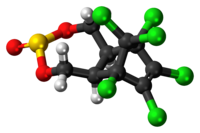| Endosulfan | |
|---|---|
 |
|
 |
|
| Identifiers | |
| CAS number | 115-29-7 |
| ChemSpider | 21117730 |
| UNII | QY5Y9R7G0E |
| KEGG | C11090 |
| Jmol-3D images | Image 1 |
| Properties | |
| Molecular formula | C9H6Cl6O3S |
| Molar mass | 406.93 g mol−1 |
| Density | 1.745 g/cm³ |
| Melting point | 70-100 °C, 343-373 K, 158-212 °F |
| Solubility in water | 0.33 mg/L |
| Hazards | |
| EU classification | Yes (T, Xi, N) |
| R-phrases | R24/25 R36 R50/53 |
| Main hazards | T, Xi, N |
| NFPA 704 | |
| Except where noted otherwise, data are given for materials in their standard state (at 25 °C, 100 kPa) |
|
| Infobox references | |
History of commercialization and regulation
- Early 1950s: Endosulfan was developed.
- 1954: Hoechst AG (now Bayer CropScience) won USDA approval for the use of endosulfan in the United States.
- 2000: Home and garden use in the United States was terminated by agreement with the EPA.
- 2002: The U.S. Fish and Wildlife Service recommended that endosulfan registration should be cancelled, and the EPA determined that endosulfan residues on food and in water pose unacceptable risks. The agency allowed endosulfan to stay on the US market, but imposed restrictions on its agricultural uses.

- 2007: International steps were taken to restrict the use and trade of endosulfan. It is recommended for inclusion in the Rotterdam Convention on Prior Informed Consent,and the European Union proposed inclusion in the list of chemicals banned under the Stockholm Convention on Persistent Organic Pollutants. Such inclusion would ban all use and manufacture of endosulfan globally. Meanwhile, the Canadian government announced that endosulfan was under consideration for phase-out, and Bayer CropScience voluntarily pulled its endosulfan products from the U.S. market but continues to sell the products elsewhere.
- 2008: In February, environmental, consumer, and farm labor groups including the Natural Resources Defense Council, Organic Consumers Association, and the United Farm Workers called on the U.S. EPA to ban endosulfan. In May, coalitions of scientists, environmental groups, and arctic tribes asked the EPA to cancel endosulfan, and in July a coalition of environmental and workers groups filed a lawsuit against the EPA challenging its 2002 decision to not ban it. In October, the Review Committee of the Stockholm Convention moved endosulfan along in the procedure for listing under the treaty, while India blocked its addition to the Rotterdam Convention.

- 2009: The Stockholm Convention's Persistent Organic Pollutants Review Committee (POPRC) agreed that endosulfan is a persistent organic pollutant and that "global action is warranted", setting the stage of a global ban. New Zealand banned endosulfan.
- 2010: The POPRC nominated endosulfan to be added to the Stockholm Convention at the Conference of Parties (COP) in April 2011, which would result in a global ban. The EPA announced that the registration of endosulfan in the U.S. will be cancelled Australia banned the use of the chemical.

- 2011: The Supreme Court on Friday banned manufacture, sale and use of toxic pesticide endosulfan in India. The apex court said the ban would remain effective for 8 weeks during which an expert committee headed by DG, ICMR, will give an interim report to the court about the harmful effect of the widely used pesticide.
- 2011: the Argentinian Service for Sanity and Agroalimentary Quality (SENASA) decided on August 8 that the import of Endosulfan into the South American country will be banned from July 1st, 2012 and its commercialization and use from July 1st, 2013. In the meantime, a reduced quantity can be imported and sold.



No comments:
Post a Comment